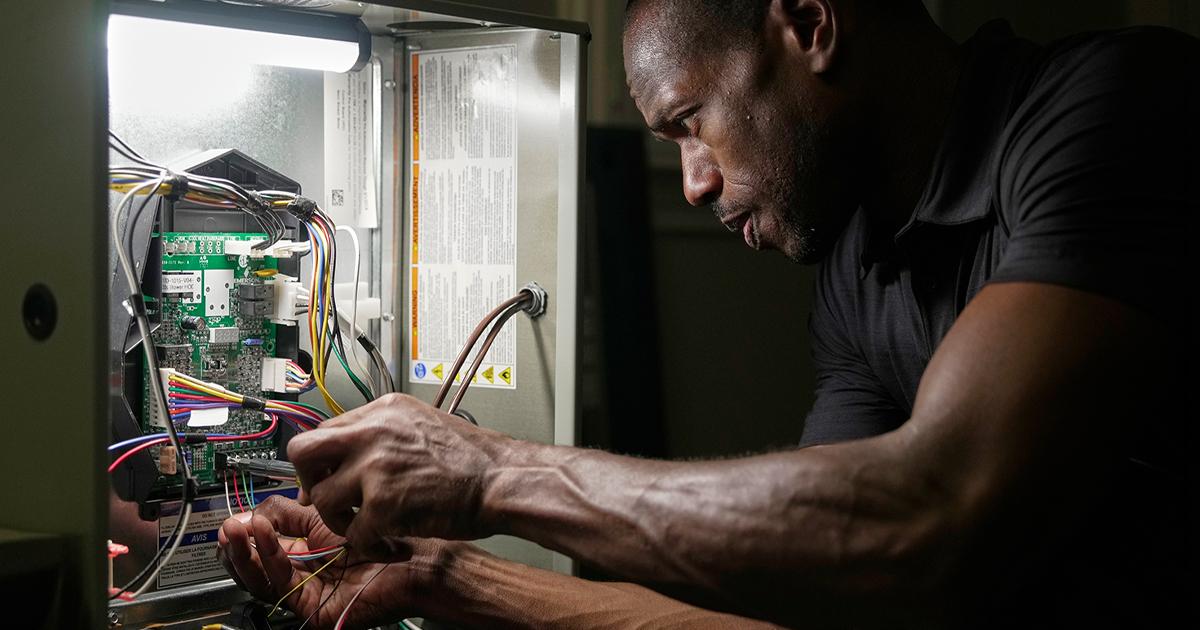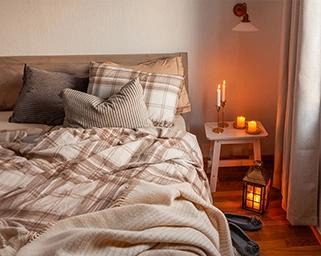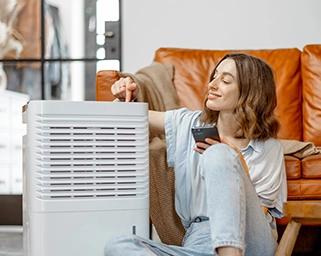How to Clean and Maintain Your Whole-House Humidifier
Maintain ideal indoor humidity in the winter or arid climates by following a few tips.
By Anne Fonda
Whole-house humidifiers can help you achieve the best humidity for your home. Living in a cold or dry area can be tough on your skin and hardwood floors. A whole-home solution can help by keeping your skin moisturized and protecting your floors. A whole-home humidifier adds moisture to the air in every room, making your home more comfortable.
According to the Environmental Protection Agency (EPA), the ideal indoor humidity ranges between 30-50%. Most people find somewhere in the 40-45% range to be ideal in winter or dry climates.
This article focuses on whole-home humidifier maintenance because that’s our area of expertise. If you have a portable humidifier, refer to the owner’s manual for cleaning and maintenance instructions.
How do I know if I have a whole-house humidifier?
This is a great question. If you moved into an existing home with a previous owner, you may need to investigate the HVAC system to find out. Find your indoor unit (furnace or air handler) in the basement, attic, roof, or utility closet.
Look for a small unit attached to the furnace or air handler connected to a water supply pipe. That’s the humidifier. If the previous owner left the manual, read through that to familiarize yourself with how it works. Otherwise, Google the model number for more information.
Why is cleaning and maintenance important?
Furnace humidifier maintenance and steam humidifier maintenance and cleaning is important to keep your humidifier running at peak performance. You want precise humidity control to keep you and your family comfortable throughout the year. Regular maintenance can also extend the lifespan of your whole-home humidifier.
Types of whole-house humidifiers
Trane dealers provide whole-house humidifier installation of 3 types of humidifiers:
- Fan-powered
- Bypass design
- Steam release
Each of these humidifiers has a humidity sensor called a humidistat that tells them when to turn on and when to shut off to reach the humidity levels you have set for home comfort.
Fan-powered humidifiers
Fan-powered humidifiers are evaporative humidifiers that connect to your furnace. They have an interior fan to move dry air through the internal water panel, which causes the air to retain moisture. This air is then dispersed through your home for balanced humidity and comfort.
Bypass humidifiers
Bypass humidifiers are sometimes known as furnace humidifiers. The bypass design has a built-in damper with summer (off) and winter (on) positions. They are compatible with any furnace. They are also known as flow-through humidifiers or drip humidifiers. A water supply line drips water onto the pad and the water evaporates, sending moisture into the air.
Steam humidifiers
A whole-house steam humidifier internally heats water in a canister and then passes the steam through a dispersion tube connected to your ductwork. There is no standing water. It’s an excellent choice for homes in arid climates or large homes up to 5,000 square feet. It works with existing ductwork and can operate independently of your HVAC system.
How often should you clean your humidifier?
Portable humidifiers with water reservoirs need to be cleaned frequently, as much as once a week. Check your owner’s manual for directions and frequency. Trane whole-house humidifiers require less frequent cleaning because of their design and the way they work.
How to clean a whole-house humidifier
First, find your owner’s manual and follow the directions to the letter. If it says certain tasks should only be performed by an HVAC professional, pay attention to that. You could void your warranty if you try to do too much.
Here are the owner’s manuals for the Trane humidifiers.
- Fan-powered humidifier owner’s manual
- Bypass humidifier owner’s manual
- Steam humidifier owner’s manual
Cleaning evaporative and bypass humidifiers
You can wipe the outside with a soft, damp cloth. To clean the inside, follow these steps.
- Turn off the water supply and disconnect from power before doing any work on your humidifier.
- Flush and clear any blockages from the strainer and drain hose.
- Check for leaks or cracks in the water inlet tube. Call an HVAC pro to replace it if needed.
- Lightly scrape or bush off any mineral buildup on the distribution tray.
- Check the evaporator screen pad. Clean it using a 1:3 solution of water to vinegar, or replace it.
- If you are cleaning annually, you can replace the humidifier pad at the same time. See details on that in the maintenance tips section below.
Steam humidifiers should only be cleaned/maintained by an HVAC professional. Contact your local Trane dealer and consider setting up a maintenance plan.
There is another, older type of whole-house humidifier called a drum humidifier with a water reservoir. Because there is constantly standing water, this type of humidifier is prone to mold growth. You need to clean the water reservoir and the foam pad frequently.
Your owner’s manual should tell you what type of humidifier you have. If you don’t have the manual, you can look up the model number online, or ask your HVAC technician. Consider upgrading to a newer model with minimal risk of mold.
What happens if you don’t clean your humidifier?
Suppose you have a portable or drum humidifier and leave it for weeks or months without cleaning. In that case, you can almost count on mold and mildew growth, and potentially bacterial growth. You should clean the foam humidifier pads in a drum humidifier monthly.
With a whole-house humidifier from Trane, the risk of mold growth is minimal because of the design of our units and the way they work.
You should check your whole-house humidifier monthly during the season to ensure it’s working properly. You may have some scale buildup that you can remove, and wipe down the outside of the unit as needed.

Maintenance Tips for Optimal Performance
There are some things you can do to maintain your whole-house humidifier yourself, and others that are best left to HVAC pros. Let’s take a look.
DIY #1: Change the humidifier pad at least annually
While some people call them humidifier filters or water pads, the industry name is humidifier pad or evaporator pad. A key maintenance step is to change the humidifier pad at least annually, or earlier if your smart thermostat gives you a notification. Furnace humidifier maintenance is for bypass and fan-powered humidifiers.
How to change a humidifier pad/evaporator pad
Humidifier pad replacement can be a DIY job or you can leave it to your HVAC technician. Replace the Humidifier Pad annually with a BAYPAD01A1010A
Humidifier Pad for Model EHUMD200 and BAYPAD02A1310A Humidifier Pad for
Model EHUMD300
- Locate your humidifier’s name and model number (usually on the back of the device) and make sure you buy the right replacement humidifier pad.
- Turn off the water source.
- Unlatch the front cover.
- Unsnap the water distribution tray and remove it.
- Slide the humidifier out of the distribution tray.
- Lightly scrape or brush off any scale deposits.
- Clean or replace the old humidifier pad with a new one with the colored spot up and snap the distribution tray back into place.
- Reinstall the evaporative assembly, lining up the feed tube and the drain into the round receptacle at the bottom of the humidifier.
- Reinstall the front cover.
- Connect the power cord or turn the unit back on.
- Test the humidifier by resetting the controls and turning the water back on.
And remember, you generally only need a new humidifier pad once a year. If this sounds like a bit much, have your HVAC technician do it.
DIY #2: Shut off the water supply to a bypass humidifier in the summer
In most areas of the country, the weather is humid enough that you should shut off the water supply to your humidifier. Your air conditioning system will help dehumidify your home.
How to shut off the water supply to your whole-house humidifier
For some models, simply close the bypass damper. With a manual control humidifier, turn the control knob to “off”. Shut off the water supply to the humidifier by closing the saddle valve - the small valve on the water supply pipe leading to the humidifier.
With an automatic control humidifier, simply shut off the water supply by closing the saddle valve. With both types, you will need to turn on the water supply again when heating season begins if you wish to use your whole-house humidifier.
DIY #3: Check and adjust humidity levels
Make a point of regularly checking humidity levels and making adjustments as needed. The recommended relative humidity (RH) levels for winter will vary based on the outdoor temperature. If the humidity gets too high, you may see signs such as condensation on the inside of your windows.
Refer to the following Trane humidifier settings table for a guideline. These should also be listed in your owner’s manual.
| Outdoor Temperature | Recommended Indoor RH |
| +40℉ | 45% |
| +30℉ | 40% |
| +20℉ | 35% |
| +10℉ | 30% |
| 0℉ | 25% |
| -10℉ | 20% |
| -20℉ | 15% |
Professional maintenance
Professional maintenance for fan-powered and bypass humidifiers
Professional furnace humidifier maintenance can be done during a furnace tuneup and includes:
- Inspecting the unit
- Flushing or replacing the in-line strainer
- Inspecting the water feed tube and replacing it if it is cracked, brittle, or damaged
- Ensuring the water supply orifice is not plugged
- Flushing clean or replacing the drain line
- Ensuring the drain line has a constant downward slope and is not flattened or blocked
- Remove mineral deposits (if any) from the distribution pad
- Replace the humidifier pad (if you haven’t already)
- Test the humidifier
Professional steam humidifier maintenance
Steam humidifier maintenance is not a DIY job and should be performed by an HVAC professional every 500 hours of service or several times during the season and includes:
- Check system operation and inspect all plumbing connections and piping for signs of cracks or leaks.
- Inspect the drain line to make sure it is clear of blockages and has a constant downward slope. Clean or replace the drain line if necessary.
- Inspect the steam hose to make sure it has no low spots and has a constant upward slope from the humidifier to the dispersion tube in the duct. If the dispersion tube is mounted below the humidifier, inspect the drip tee drain
- Replace the canister annually and when prompted by the “Service” light based on hard or soft water.
- Test and reset the humidifier.
Work with the HVAC experts
If your humidifier isn’t working or you need to schedule HVAC maintenance, contact your local Trane dealer for help. From Texas to Pennsylvania to California and Arizona, we have your HVAC and indoor air quality needs covered.
Schedule annual HVAC maintenance to have technicians inspect and service your humidifier and other system components for peak performance.
Anne Fonda, Content Writer
A Content Writer with Trane Technologies, Anne Fonda researches topics and writes for Trane® and associated residential HVAC brands. She works in collaboration with Trane Technologies subject matter experts, offering easy-to-understand, informative content on complex topics. Her goal is to help consumers make informed decisions on the products and services they need.
She has written for HVAC and other service provider websites for over 16 years. Before transitioning to web content writing, Anne had a 14-year stint as an award-winning journalist. She graduated cum laude from the University of Missouri-Columbia School of Journalism.
When she’s not working, Anne enjoys playing word games, reading, gardening, spending time with family, and visiting gardens and museums.
Expert review by Sean Goddard, Product Manager, Coils & Indoor Air Quality




